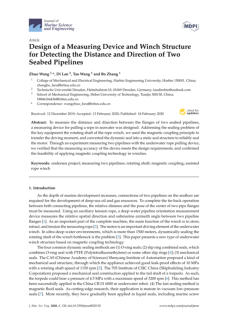

This brochure describes the various mooring systems in
use for floating facilities. SBM Offshore is a recognized
market and technology leader for Turrets and Mooring
Systems (TMS), having supplied over 100 permanent
mooring systems worldwide.

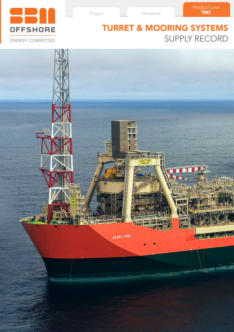

This document describes the step by step the installation
of the Split sleeve Plidco.
A corresponding animation is available in “Videos &
animations”

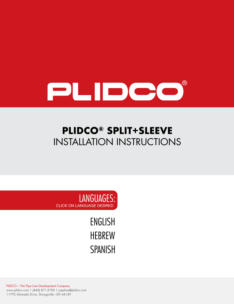

This document describes the step by step the installation
of the Smith + Clamp Plidco.
A corresponding animation is available in “Videos &
animations”

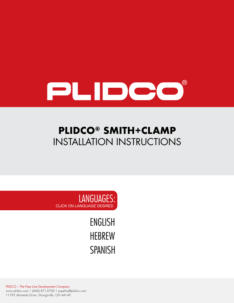


A two-dimensional model based on Open Tidal Farm is
applied to simulate tidal stream flow around turbines. The
model is governed by shallow water equations and can
optimize the layout of the deployed turbine array to
maximize the energy outputs. Three turbine array layouts,
including two structured designs (regular and staggered)
and one unstructured layout (optimized), are simulated to
investigate the effect of turbine layouts on energy
extraction. The present study shows that more energy
could be extracted when lateral spacing decreases and
longitudinal spacing increases within the same domain,
namely the effective turbine layout is to deploy more
turbines in the first row to extract energy from an
undisturbed tidal stream, while larger longitudinal spacing
will make it possible for a tidal stream to recover more
before reaching the next turbines row. Taking the tidal
stream turbines array around Zhoushan Islands as a case
study, results show that the optimized layout can extract
106.8% energy of that extracted by the regular and
staggered design for a full tide in the same marine area.
Additionally, the turbine array greatly influences tidal
stream velocities immediately behind the array and has
little effect on far-field wake flow.

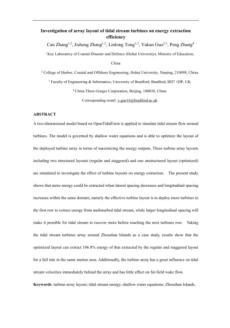

This paper briefly reviews the available and proposed
solutions for the tidal current turbines. The idea is to
overview the different types of technologies involved in
the tidal current energy conversion systems rather than
summarize the different market solutions. The paper
concludes by highlighting the major challenges faced by
the tidal current turbine industry and an indication of the
current trends in the industry.

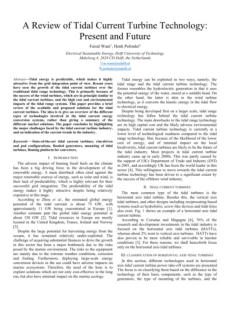

Authors:
Vahid Aryai, Rouzbeh Abbassi, Nagi Abdussamie,
Fatemeh Salehi, Vikram Garaniya, Mohsen Asadnia, Al-
Amin Baksh, Irene Penesis, Hassan Karampour, Scott
Draper, Allan Magee, Ang Kok Keng, Chris Shearer, Suba
Sivandran, Lim Kian Yew, Denham Cook, Mark
Underwood, Andrew Martini, Kevin Heasman, Jonathan
Abrahams, Chien-Ming Wang.
This document reviews the status, limitations, and future
directions of offshore fishing facilities in Australia.

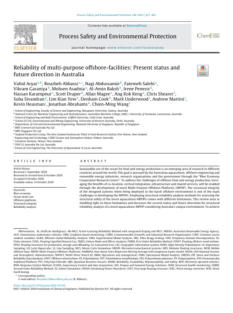

Author:
Zhiyu Jiang
This paper presents a state-of-the-art review of the
technical aspects of offshore wind turbine installation. An
overview is first presented, introducing the classification of
offshore wind turbines, installation vessels, rules and
regulations, and numerical modeling tools. Then, various
installation methods and concepts for bottom-fixed and
floating wind turbines are critically discussed, following the
order of wind turbine foundations and components. The
applications and challenges of the methods are identified.
Finally, future developments in four technical areas are
envisioned.

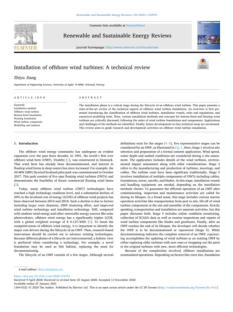

Authors:
Karthik Balasubramanian, Sudhakar Babu Thanikanti,
Umashankar Subramaniam, N.Sudhakar. & Sam Sichilalu.
This paper aims to help scientists, and new entrants, in the
field of modeling and layout optimization of wind farms. It
highlights the research regarding wind farm modeling. It
also addresses new approaches used for this purpose and
evaluates existing methodologies.

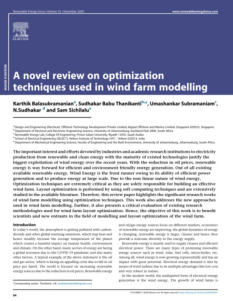

Authors:
Yan Xu, Kun Yang, Guohao Zhao
This paper analyzes the factors that affect the offshore
wind power industry. Fourteen factors are selected, and
an interpretative structural model (ISM) is established to
study the relationship between the influencing factors of
the offshore wind power industry.

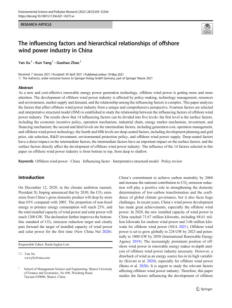

Authors:
Dave J. Pojadas, Michael Lochinvar Sim Abundo
The year 2020 marks the start of the implementation of
the Renewable Portfolio Standards in the Philippines. The
case for grid-connected island provinces is interesting
because of the opportunity for self-sustainable energy
production. In this paper, the authors assess the adequacy
of domestic renewable energy resources of Bohol
province to reach this target by estimating the technical
potential of solar, wind, biomass, and hydropower using
Spatio-temporal datasets.

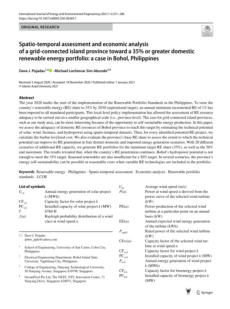

Authors:
Ting Zhang, Bo tian, Dhritiraj Sengupta, Lei Zhang, & Yali
Si.
The authors of this document have constructed a global
remote sensing-based offshore wind turbine (OWT)
database derived from Sentinel-1 synthetic aperture radar
(SAR) time-series images from 2015 to 2019. They have
developed a percentile-based yearly SAR image collection
reduction and auto-adaptive threshold algorithm in the
Google Earth Engine platform to identify the
spatiotemporal distribution of global OWTs. By 2019,
6,924 wind turbines were constructed in 14 coastal
nations. An algorithm performance analysis and validation
were performed, and the extraction accuracies exceeded
99% using an independent validation dataset. This dataset
could further the understanding of the environmental
impact of OWTs and support effective marine spatial
planning for sustainable development.

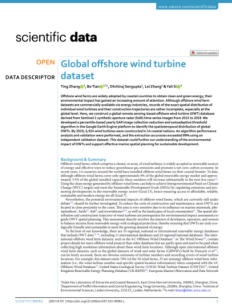

Wave energy is one of the renewable resources with high
availability area of the wave across the world. However,
the wave power density in Malaysia is smaller compared
to other countries with progressive development in Wave
Energy Converter (WEC), which leads to wave energy
utilization to produce pico-scale power generation for the
benefit of outdoor activities. Thus, this paper presents the
modeling of a tubular longitudinal permanent magnet
linear generator for wave energy conversion for outdoor
activities.

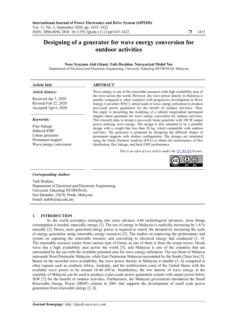

Authors:
Hongwei Fang, Yu Wei, & Yuzhu Feng.
In the paper, a novel dual-rotor permanent magnet
synchronous generator (DRPMSG) for wave power
generation is designed.
The no-load reaction characteristics and load reaction
characteristics of the DRPMSG are analyzed with back-
EMF, air gap magnetic density harmonic, torque, and
current results presented. A significant advantage of this
machine is that it can achieve variable stiffness adjustment
for wave energy conversion.

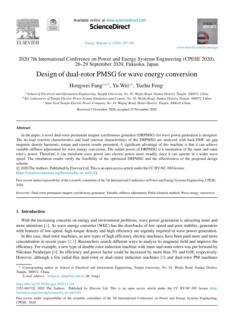

Authors:
Philippe Sergent, Virginie Baudry, Arnaud De Bonviller,
Bertrand Michard, & Jérémy Dugor.
There are few general analyses of the interest of onshore
wave energy converters (onshore WEC) in terms of
resources, efficiency, and cost. The case of The Channel
on the Atlantic coast of France is chosen here to illustrate
the issues related to onshore WEC development. The
paper presents a list of potential sites with their
characteristics and a more in-depth analysis of a few sites.

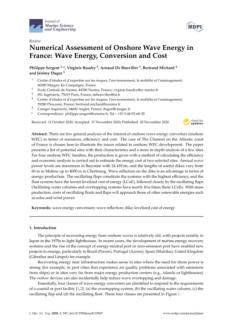

Authors: Nur Amirah Abdul Jamil, Siti Amely Jumaat,
Suriana Salimin, Mohd Noor Abdullah, Ahmad
Fateh Mohamad Nor.
This paper presents Performance Enhancement of Solar
Powered Floating Photovoltaic System using "Arduino"
approach. The objective of this project is to monitor the
performance of the voltage, current, and power output,
respectively. Furthermore, the research prototype is tested
on water surfaces and land areas.
"Arduino" is an open-source platform based on easy-to-use
hardware and software.

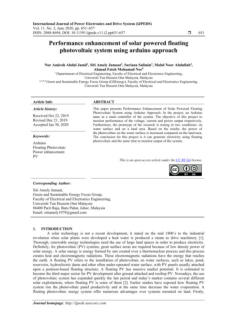

Authors: Hasnain Yousuf, Muhammad Quddamah
Khokhar, Muhammad Aleem Zahid, Jaeun Kim,
Youngkuk Kim, Eun-Chel Cho, Young Hyun Cho,
Junsin Yi.
This article gives a logical investigation and shows the
different features and components of floating photovoltaic
technology (FPVT) systems and the influence of
implementing these systems. Also, a comparison that
reveals the pros and cons of various types of solar systems
that could be installed in various locations is provided.

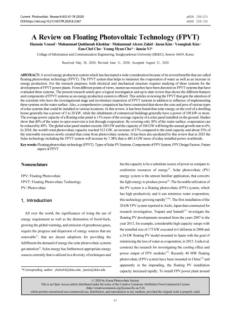

Authors: L Meng, R Y Huang, J Qin, J X Wang, and L T Liu
To investigate the influence of rigid wall surfaces on the
bubble characteristics of an underwater explosion, the
underwater explosion experiment under the boundary
conditions of free surface and rigid wall surface was
carried out on 2.5g cylindrical charge TNT in a 2×2×2m
tank. An underwater pressure sensor obtained the time
history curves of shock wave and bubble pulsation, and
the bubble pulsation process was observed by high-speed
photography.

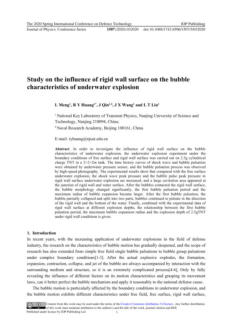

Authors: Xinjian Xu and Zhaoxing Meng
The ultra-high pressure water jet is a kind of high-energy
water jet, which is pressurized by a high pressure pump to
make the pressure reach hundreds or even thousands of
megapascals, and ejects a high-energy water stream from
the nozzle with special aperture at a very high speed of
100-1000m / s.
The water stream has a very strong hitting power, and
can cut, break, pierce, remove and clean various materials,
etc.



Authors: Oleg Urazmetov, Marcel Cadet, Roman Teutsch,
Sergiy Antonyuk
High-pressure water jets are often used as a tool for
cleaning, cutting or for modification of the surface
morphology.
The nozzle design has a considerable influence on
cavitation and wear effects as well as on the nature of the
exiting jets.
Different applications are affected by different flow
regimes, such as cavitation or hydraulic-flip, which
depend on the radius of the nozzle edge.

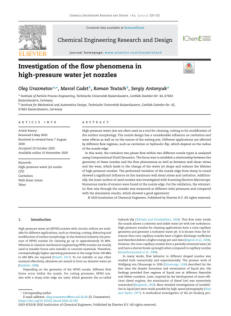

Click on the
octopus to return to
the top of the page
Underwater construction 2020







Authors:
Jian Yin, Jing Yang, Minglong Bai, Tao Lv, and Yiru Suo
Pouring concrete underwater is a widely used technique
that has proven its worth in the field. To ensure the
smooth operation of this method, the construction crew
must adhere to and strictly follow the established
procedures and technical specifications. This is essential to
guarantee that the structural integrity of the underwater
concrete piles will meet all the necessary design standards
and regulations.





Authors: Xiangyuan Zheng, Huadong Zheng, Yu Lei, Yi Li,
& We Li
This document describes a new concept design
integrating multiple megawatt vertical-axis wind turbines
(VAWTs), a solar array, and a floating steel fish-farming
cage into a combined wind-solar-aquaculture (WSA)
system. It highlights the benefits of this system in terms of
effective and economical utilization of ocean space and
water resources, as well as its potential to shorten the
payback period for offshore power generation
investments. It also provides technical details about the
design, its hydrodynamic performance, and its feasibility
for deployment in the northwest South China Sea,
emphasizing its strong competitiveness and prospects in
the offshore industry.

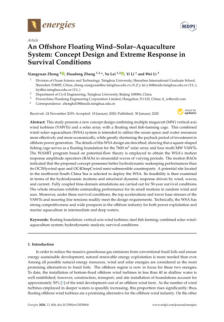

Authors: Pei Zhang, Shugeng Yang, Yan Li, Jiayang Gu,
Zhiqiang Hu, Ruoyu Zhang, & Yougang Tang
This study investigates the dynamic behaviors of different
types of articulated foundations for supporting a 5 MW
offshore wind turbine in transitional depth offshore areas
(50 m to 75 m). It involves numerical simulations to
analyze the dynamic responses under various water
depths, considering aerodynamic and hydrodynamic
loads. The authors also compare the performance of three
different articulated foundations, highlighting that all
designs meet power generation requirements, with the
shallower foundation exhibiting more severe oscillations.

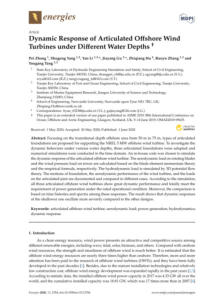

Authors: Saleh Jalbi, Joseph Hilton, and Luke Jacques
This document is a comparative analysis of different
methodologies for predicting the long-term behavior of
offshore wind turbine monopiles under cyclic loading
conditions. It highlights the limitations of conventional
cyclic p-y curves and emphasizes the importance of
considering the loading profile and number of cycles in
predicting accumulated rotations. It also seeks to
demonstrate the impact of pile flexibility on the results and
to contribute to the design and interpretation of future
experimental frameworks for offshore wind turbine
monopiles in sandy soils.



Authors: Osamah Sarhan, Mahdy Raslan
This paper provides an overview and general guidance
on planning, designing, analyzing, constructing, and
installing jacket-type offshore platforms used for oil and
gas extraction. It summarizes and classifies various aspects
of these structures, highlighting their importance,
suitability for shallow water, stability features, and
associated costs.

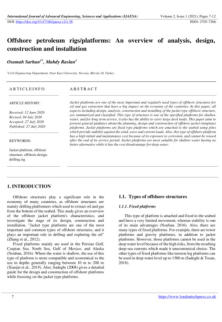

Authors: Fernando Cañizal, Jorge Castro, Jorge Cañizal,
and César Sagaseta
This paper analyzes the behavior of ultrathin rigid plate
anchors in cohesive soils, highlighting their significance in
supporting floating platforms. It discusses factors
influencing pull-out capacity, provides weightless break-
out factor values from finite element analyses, identifies
three failure mechanisms, reviews existing analytical
solutions for shallow and deep failures, proposes a new
analytical limit for shallow mechanisms, and numerically
evaluates the angle of slip lines for intermediate failures.

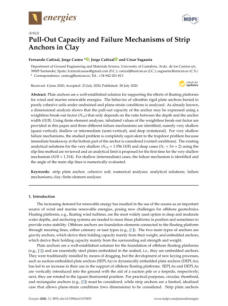

Authors: Michael Borg, Morten Walkusch Jensen, Scott
Urquhart, Morten Thøtt Andersen, Jonas Bjerg
Thomsen, and Henrik Stiesdal
This paper informs and facilitates discussion about the
TetraSpar demonstrator, a cost-reducing innovation in
offshore floating wind turbines. It describes the design of
the TetraSpar foundation to enable educated discussions
on different design philosophies, material usage, and
production times. It also encourages an open approach to
technological discussion to achieve continued cost
reduction in floating offshore wind technology.

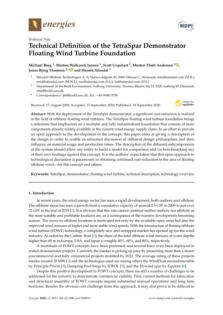

Authors: Pim van der Male, Marco Vergassola, and Karel
N. van Dalen
This document reviews advanced modeling approaches
for environmental interactions with offshore wind support
structures, focusing on monopile foundations. It identifies
current challenges, discusses practical and commercial
reasons for decoupled modeling, and highlights the
importance of balancing computational costs with model
complexity, particularly during the preliminary design
stage.

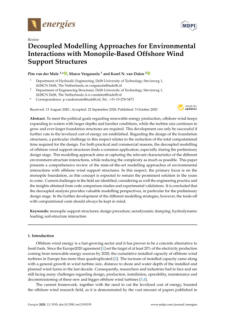

Publisher:
French Committee for Soils Mechanics and Geothechnics
This document provides guidelines for planning,
designing, building, and installing the foundations of fixed
offshore wind turbines, focusing on geotechnical aspects
and ground-structure interactions. It covers specific
foundation types such as monopiles, piles, and gravity
bases. It aims to serve as a technical reference and is
complementary to international standards. The
recommendations also address specific soil conditions
found on the French continental shelf and incorporate
findings regarding pile dimensioning under cyclic
loadings..

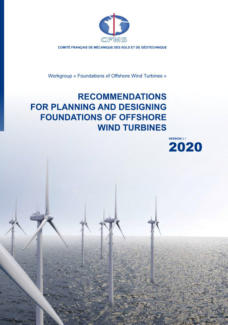

Publisher:
Tsung-Yueh Lin, Yi-Qing Zhao, and Hsin-Haou Huang
This study estimates 20-year cumulative fatigue damage to
an offshore jacket substructure under long-term local
environmental conditions in the Taiwan Strait. The study
involves time-domain simulations of a dynamic finite
element model for each sea state due to the nonlinearity
of wave load on slender members of the structure. It
utilizes the Dirlik method to process stress signals and
compute the fatigue damage to joints. Additionally, the
study proposes a probability-based method to reduce
computational time using a representative combination of
environmental conditions, improving the preliminary
design process..

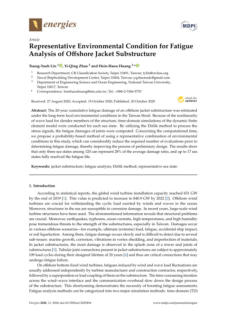

Authors: Dimitris Souravlias , Ioannis Dafnomilis , Jens Ley,
Gerrit Assbrock, Mark B. Duinkerken, Rudy R.
Negenborn, and Dingena L. Schott
IThis paper details a methodology for designing and
developing a floating, modular offshore port terminal to
expand the container handling capacity of existing ports.
The authors outline the challenges of such a project and
describe a comprehensive approach that includes
terminal layout design, strategic logistics optimization, and
operational process coordination. The methodology is
demonstrated through a case study focused on
accommodating port growth in the Hamburg-Le Havre
range.

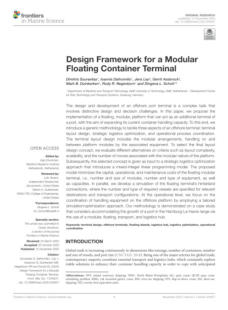

Authors: Wang-chun Zhang, Hao Jing, and Hai-lei Kou
This document studies the interface shear behavior
between sand and concrete, specifically in the context of
installing suction caissons as foundations for offshore wind
turbines. It investigates how factors such as the concrete
surface's relative roughness and the sand's mean particle
size influence the shear stress and friction angle at the
interface. The text aims to convey the experimental results
and their implications for understanding the mechanical
interactions between sand and concrete in such
engineering applications.

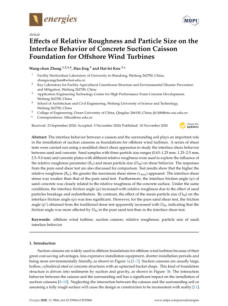

Authors: Yuqi Wang, Fuyou Xu, and Zhanbiao Zhang
This paper conveys the results and significance of a study
on the impact of freak waves, specifically the "New Year
Wave" (NYW), on offshore renewable energy structures
such as tension-leg platforms (TLPs) and monopile
foundations of offshore wind turbines (OWTs). This study
involves numerical simulations using Computational Fluid
Dynamics (CFD) methods to analyze the inline forces and
secondary load cycles (SLC) on vertical-mounted cylinders,
which represent these structures. It highlights the
relationship between SLC development and downstream
vortex and return flow, as well as the discrepancies
between simulation results and empirical formulations.

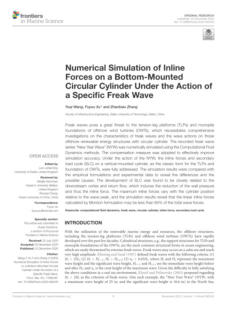

Authors: Kai Wei, Cong Zhou, Mingjin Zhang, Zilong Ti, &
Shunquan Qin
This study reviews research on the hydrodynamic effects
on elevated pile cap foundations used in sea-crossing
bridges, including the interactions of waves and currents,
the hydrodynamic load on the foundations, fluid-structure
interactions, and the structural responses of bridges
supported by these foundations. Additionally, it discusses
future research prospects in this field, such as wave-
current interaction mechanisms, wave-current loads, fully
coupled fluid-structure interactions, and the structural
dynamic response under combined hydrodynamic and
other hazards..

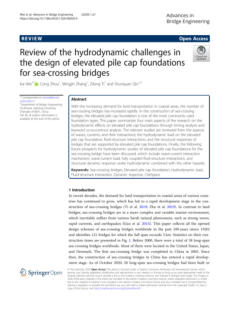

Authors: Liquan Wang, Ming Ju, Xiaodong Xing, Feihong
Yun, & Xiangyu Wang
This study describes the establishment of a coupled
dynamic model to analyze the effects of various factors on
pipeline dynamics, using theories and software tools like
AQWA and OrcaFlex to convey the findings of the study,
highlighting the significant impact of marine loads, vessel
motion, and particularly surface waves on the pipeline's
dynamic response during the laying process.

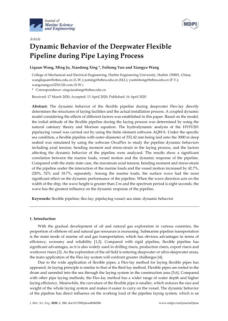



2 - Review of cage and containment tank designs for offshore fish
farming
Authors: Y.I. Chu,Wang, J.C. Park, P.F. Lader
Fish farm operators are moving offshore due to limited
nearshore sites, community opposition, and conflicts with
various activities. Offshore areas offer more space and
better water quality. This paper defines offshore fish
farming, reviews cage designs, and discusses the
advantages and challenges of different systems. It also
examines co-location with other industries for future
developments.
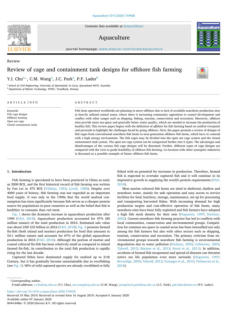



37 - Comparative study of design methodologies regarding a
shallow foundation of a pipeline end manifold (PLEM)
Authors: Aluizio de A. Pacheco, Leonardo S. do
Nascimento, Renata G. Faisca
The Pipeline End Manifold (PLEM) is used in underwater
oil and gas production to divide the flow into several
routes to an FPSO. It has a rectangular mudmat
foundation that faces various loads. The design must
assess bearing capacity, sliding effects, and settlement
using standard calculations or the Finite Element Method
(FEM). This paper compares three design standards for
shallow foundations of subsea structures and analyzes
the interaction between PLEM and soil through FEM,
aiding engineers in choosing the best design code.
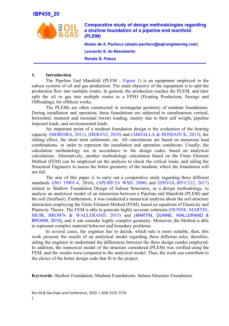



3 - Design of a Measuring Device and Winch Structure for
Detecting the Distance and Direction of Two Seabed Pipelines
Authors: Zhuo Wang, Di Lan, Tao Wang, and Bo Zhang
This document describes a seabed pipeline measuring
device tha was designed to accurately measure distance
and direction between flanges using a magnetic
coupling principle. This device effectively sealed the
rotating shaft of the rope winch, confirming its feasibility
in winches.
